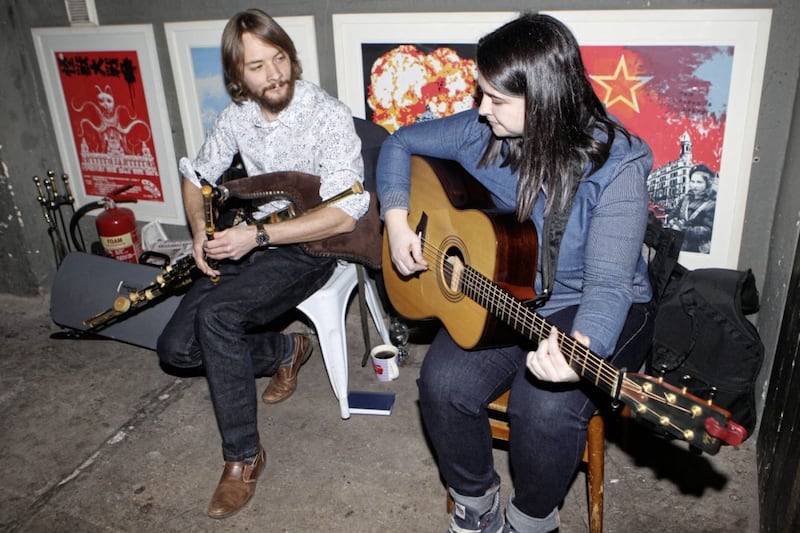BELFAST is buzzing these days and undoubtedly part of the vibe is being provided by a truly remarkable renaissance in traditonal music that has been providing an alternative soundtrack to the city since the dawn of the millennium and before.
Of course, Belfast has always had a long, hidden tradition of folk music with the McPeakes (great friends of the Beatles), Sean Maguire, Sean McAloon and others but now hope and history have rhymed and there is a critical mass of hugely talented young people playing trad, venues which give them a platform and an ever-growing audience for Belfast’s unique take on one of the world’s great artforms.
That’s why the pioneering people at An Droichead, the Irish language and culture organisation on the Ormeau Road, have come up with the brilliant idea of running a Traditional Music Walking Tour – the Trad Trail for short – in Belfast’s Cathedral Quarter to give locals and tourists alike the opportunity to hear great music, learn about its history, the instruments, Irish dancing and song in three city centre hostelries.
Thursday saw the first of its kind with a group of us and it was hugely enjoyable.
Starting off in the Dirty Onion in Hill Street, the sign above the fire tells it all. “Bíonn Siúlach Scéalach” it says, meaning that travellers always have stories to tell and after the two-hour tour in the company of uilleann piper Conor Lamb and guitarist and singer Deirdre Galway we heard a lot of stories about the music itself but also about the history of Belfast.
At the second venue, The Duke of York, Conor and Deirdre explained the differences between a reel, a jig and a slip jig, playing us examples of each. Now whenever I hear a tune, I’ll know what it is but would you know the difference between a barndance and a strathspey? If not, the guys are very willing to answer all questions no matter how silly they may seem to you.
Most Belfast musicians prefer to play reels and it is suggested this might be because it relfects the pace of life in the city, whereas Kerry is known for its slides, Donegal for its Highlands and so on.
Conor then went on to play what I call Ireland's great contribution to world culture, the slow air on the uilleann pipes – in this case, the gorgeous Lament for Limerick. It was quite breathtaking.
Conor then described the wonderful instrument he as playing. The uilleann pipes must be one of the most difficult instruments to master, with its chanters and regulators and diva-like qualities of the reed. He told us that the pipes used to be used in churches to stand in for an organ.
Another person on the tour, Chris Caldwell, told me of a meeting of pipers near Dublin in the 1960s. Of the 60 who turned up only six were from the north and five of those were Presbyterian ministers!
It was off again to the third and final destination, McHugh’s, but of course we passed by the derelict Northern Bank building, the scene of Belfast’s finest musical moment.
Belfast was also buzzing back in 1792 when it was the most radical town in Ireland, having been gripped by the ideas that flowed from the French Revolution just three years before. Here at home, the United Irishmen were on a mission to unite Catholic, Protestant and Dissenter and patriotism, especially among Presbyterians, was the order of the day.
Three of them – James McDonnell, Henry Joy (who owned the Belfast News Letter with his brother Robert) – and Thomas Russell decided to organise a Belfast Harpers Assembly.
To get sponsors they put an article in the News Letter, saying that: Some inhabitants of Belfast, feeling themselves interested in everything which relates to the Honor, as well as the Prosperity of their country; propose to open a subscription which they intend to apply in attempting to revive and perpetuate THE ANCIENT MUSIC AND POETRY OF IRELAND. They are solicitous to preserve from oblivion the few fragments, which have been permitted to remain as Monuments of the refined Taste and Genius of their Ancestors.”
The resulting festival ran from July 11–14 1792 and the tunes were transcribed by a classically trained 19-year-old from Armagh, Edward Bunting, who was also an organist at St George’s Church on High Street which we passed, a definite spring in our step as the music played around in our heads.
At McHugh’s we were met by dancer Ciara Cullen who told us a bit about the history of Irish dance before giving us a breathtaking demonstration, the clickety-clack of shoe on floor bouncing around the room accompanied by the driving rhythyms of Conor and Deirdre.
Then we were asked if anyone would like to sing. There was just one taker – Chris – who sang a song in praise of Guinness and the Dublin Boozaleers!
The small upstairs rooms in both the Duke of York and McHugh’s were perfect for the music and created a lovely intimate, relaxed atmosphere. When the tours really take off, I can imagine lots of people taking the opportunity to sing a few songs as twilight sets in outside on of the oldest buildings in the city.
:: The Belfast Trad Trail is now taking bookings for groups and will be taking bookings from individuals and smaller groups starting in May. The tours last round 2.5 hours and will start at 5pm. For more see belfasttradtrail.com or email info@belfasttradtrail.com



